Wenwen Qiang
Group Causal Policy Optimization for Post-Training Large Language Models
Aug 07, 2025Abstract:Recent advances in large language models (LLMs) have broadened their applicability across diverse tasks, yet specialized domains still require targeted post training. Among existing methods, Group Relative Policy Optimization (GRPO) stands out for its efficiency, leveraging groupwise relative rewards while avoiding costly value function learning. However, GRPO treats candidate responses as independent, overlooking semantic interactions such as complementarity and contradiction. To address this challenge, we first introduce a Structural Causal Model (SCM) that reveals hidden dependencies among candidate responses induced by conditioning on a final integrated output forming a collider structure. Then, our causal analysis leads to two insights: (1) projecting responses onto a causally informed subspace improves prediction quality, and (2) this projection yields a better baseline than query only conditioning. Building on these insights, we propose Group Causal Policy Optimization (GCPO), which integrates causal structure into optimization through two key components: a causally informed reward adjustment and a novel KL regularization term that aligns the policy with a causally projected reference distribution. Comprehensive experimental evaluations demonstrate that GCPO consistently surpasses existing methods, including GRPO across multiple reasoning benchmarks.
Hacking Hallucinations of MLLMs with Causal Sufficiency and Necessity
Aug 06, 2025



Abstract:Multimodal Large Language Models (MLLMs) have demonstrated impressive capabilities across vision-language tasks. However, they may suffer from hallucinations--generating outputs that are semantically inconsistent with the input image or text. Through causal analyses, we find that: (i) hallucinations with omission may arise from the failure to adequately capture essential causal factors, and (ii) hallucinations with fabrication are likely caused by the model being misled by non-causal cues. To address these challenges, we propose a novel reinforcement learning framework guided by causal completeness, which jointly considers both causal sufficiency and causal necessity of tokens. Specifically, we evaluate each token's standalone contribution and counterfactual indispensability to define a token-level causal completeness reward. This reward is used to construct a causally informed advantage function within the GRPO optimization framework, encouraging the model to focus on tokens that are both causally sufficient and necessary for accurate generation. Experimental results across various benchmark datasets and tasks demonstrate the effectiveness of our approach, which effectively mitigates hallucinations in MLLMs.
Causal Reward Adjustment: Mitigating Reward Hacking in External Reasoning via Backdoor Correction
Aug 06, 2025Abstract:External reasoning systems combine language models with process reward models (PRMs) to select high-quality reasoning paths for complex tasks such as mathematical problem solving. However, these systems are prone to reward hacking, where high-scoring but logically incorrect paths are assigned high scores by the PRMs, leading to incorrect answers. From a causal inference perspective, we attribute this phenomenon primarily to the presence of confounding semantic features. To address it, we propose Causal Reward Adjustment (CRA), a method that mitigates reward hacking by estimating the true reward of a reasoning path. CRA trains sparse autoencoders on the PRM's internal activations to recover interpretable features, then corrects confounding by using backdoor adjustment. Experiments on math solving datasets demonstrate that CRA mitigates reward hacking and improves final accuracy, without modifying the policy model or retraining PRM.
Multi-Modal Learning with Bayesian-Oriented Gradient Calibration
May 29, 2025Abstract:Multi-Modal Learning (MML) integrates information from diverse modalities to improve predictive accuracy. However, existing methods mainly aggregate gradients with fixed weights and treat all dimensions equally, overlooking the intrinsic gradient uncertainty of each modality. This may lead to (i) excessive updates in sensitive dimensions, degrading performance, and (ii) insufficient updates in less sensitive dimensions, hindering learning. To address this issue, we propose BOGC-MML, a Bayesian-Oriented Gradient Calibration method for MML to explicitly model the gradient uncertainty and guide the model optimization towards the optimal direction. Specifically, we first model each modality's gradient as a random variable and derive its probability distribution, capturing the full uncertainty in the gradient space. Then, we propose an effective method that converts the precision (inverse variance) of each gradient distribution into a scalar evidence. This evidence quantifies the confidence of each modality in every gradient dimension. Using these evidences, we explicitly quantify per-dimension uncertainties and fuse them via a reduced Dempster-Shafer rule. The resulting uncertainty-weighted aggregation produces a calibrated update direction that balances sensitivity and conservatism across dimensions. Extensive experiments on multiple benchmark datasets demonstrate the effectiveness and advantages of the proposed method.
On the Transferability and Discriminability of Repersentation Learning in Unsupervised Domain Adaptation
May 28, 2025Abstract:In this paper, we addressed the limitation of relying solely on distribution alignment and source-domain empirical risk minimization in Unsupervised Domain Adaptation (UDA). Our information-theoretic analysis showed that this standard adversarial-based framework neglects the discriminability of target-domain features, leading to suboptimal performance. To bridge this theoretical-practical gap, we defined "good representation learning" as guaranteeing both transferability and discriminability, and proved that an additional loss term targeting target-domain discriminability is necessary. Building on these insights, we proposed a novel adversarial-based UDA framework that explicitly integrates a domain alignment objective with a discriminability-enhancing constraint. Instantiated as Domain-Invariant Representation Learning with Global and Local Consistency (RLGLC), our method leverages Asymmetrically-Relaxed Wasserstein of Wasserstein Distance (AR-WWD) to address class imbalance and semantic dimension weighting, and employs a local consistency mechanism to preserve fine-grained target-domain discriminative information. Extensive experiments across multiple benchmark datasets demonstrate that RLGLC consistently surpasses state-of-the-art methods, confirming the value of our theoretical perspective and underscoring the necessity of enforcing both transferability and discriminability in adversarial-based UDA.
Reward Model Generalization for Compute-Aware Test-Time Reasoning
May 23, 2025Abstract:External test-time reasoning enhances large language models (LLMs) by decoupling generation and selection. At inference time, the model generates multiple reasoning paths, and an auxiliary process reward model (PRM) is used to score and select the best one. A central challenge in this setting is test-time compute optimality (TCO), i.e., how to maximize answer accuracy under a fixed inference budget. In this work, we establish a theoretical framework to analyze how the generalization error of the PRM affects compute efficiency and reasoning performance. Leveraging PAC-Bayes theory, we derive generalization bounds and show that a lower generalization error of PRM leads to fewer samples required to find correct answers. Motivated by this analysis, we propose Compute-Aware Tree Search (CATS), an actor-critic framework that dynamically controls search behavior. The actor outputs sampling hyperparameters based on reward distributions and sparsity statistics, while the critic estimates their utility to guide budget allocation. Experiments on the MATH and AIME benchmarks with various LLMs and PRMs demonstrate that CATS consistently outperforms other external TTS methods, validating our theoretical predictions.
CAIFormer: A Causal Informed Transformer for Multivariate Time Series Forecasting
May 22, 2025

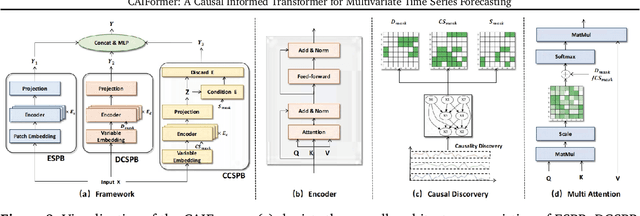

Abstract:Most existing multivariate time series forecasting methods adopt an all-to-all paradigm that feeds all variable histories into a unified model to predict their future values without distinguishing their individual roles. However, this undifferentiated paradigm makes it difficult to identify variable-specific causal influences and often entangles causally relevant information with spurious correlations. To address this limitation, we propose an all-to-one forecasting paradigm that predicts each target variable separately. Specifically, we first construct a Structural Causal Model from observational data and then, for each target variable, we partition the historical sequence into four sub-segments according to the inferred causal structure: endogenous, direct causal, collider causal, and spurious correlation. The prediction relies solely on the first three causally relevant sub-segments, while the spurious correlation sub-segment is excluded. Furthermore, we propose Causal Informed Transformer (CAIFormer), a novel forecasting model comprising three components: Endogenous Sub-segment Prediction Block, Direct Causal Sub-segment Prediction Block, and Collider Causal Sub-segment Prediction Block, which process the endogenous, direct causal, and collider causal sub-segments, respectively. Their outputs are then combined to produce the final prediction. Extensive experiments on multiple benchmark datasets demonstrate the effectiveness of the CAIFormer.
Learning to Think: Information-Theoretic Reinforcement Fine-Tuning for LLMs
May 15, 2025Abstract:Large language models (LLMs) excel at complex tasks thanks to advances in reasoning abilities. However, existing methods overlook the trade-off between reasoning effectiveness and computational efficiency, often encouraging unnecessarily long reasoning chains and wasting tokens. To address this, we propose Learning to Think (L2T), an information-theoretic reinforcement fine-tuning framework for LLMs to make the models achieve optimal reasoning with fewer tokens. Specifically, L2T treats each query-response interaction as a hierarchical session of multiple episodes and proposes a universal dense process reward, i.e., quantifies the episode-wise information gain in parameters, requiring no extra annotations or task-specific evaluators. We propose a method to quickly estimate this reward based on PAC-Bayes bounds and the Fisher information matrix. Theoretical analyses show that it significantly reduces computational complexity with high estimation accuracy. By immediately rewarding each episode's contribution and penalizing excessive updates, L2T optimizes the model via reinforcement learning to maximize the use of each episode and achieve effective updates. Empirical results on various reasoning benchmarks and base models demonstrate the advantage of L2T across different tasks, boosting both reasoning effectiveness and efficiency.
Causal Prompt Calibration Guided Segment Anything Model for Open-Vocabulary Multi-Entity Segmentation
May 10, 2025Abstract:Despite the strength of the Segment Anything Model (SAM), it struggles with generalization issues in open-vocabulary multi-entity segmentation (OVMS). Through empirical and causal analyses, we find that (i) the prompt bias is the primary cause of the generalization issues; (ii) this bias is closely tied to the task-irrelevant generating factors within the prompts, which act as confounders and affect generalization. To address the generalization issues, we aim to propose a method that can calibrate prompts to eliminate confounders for accurate OVMS. Building upon the causal analysis, we propose that the optimal prompt for OVMS should contain only task-relevant causal factors. We define it as the causal prompt, serving as the goal of calibration. Next, our theoretical analysis, grounded by causal multi-distribution consistency theory, proves that this prompt can be obtained by enforcing segmentation consistency and optimality. Inspired by this, we propose CPC-SAM, a Causal Prompt Calibration method for SAM to achieve accurate OVMS. It integrates a lightweight causal prompt learner (CaPL) into SAM to obtain causal prompts. Specifically, we first generate multiple prompts using random annotations to simulate diverse distributions and then reweight them via CaPL by enforcing causal multi-distribution consistency in both task and entity levels. To ensure obtaining causal prompts, CaPL is optimized by minimizing the cumulative segmentation loss across the reweighted prompts to achieve consistency and optimality. A bi-level optimization strategy alternates between optimizing CaPL and SAM, ensuring accurate OVMS. Extensive experiments validate its superiority.
Enhancing Human Motion Prediction via Multi-range Decoupling Decoding with Gating-adjusting Aggregation
Mar 30, 2025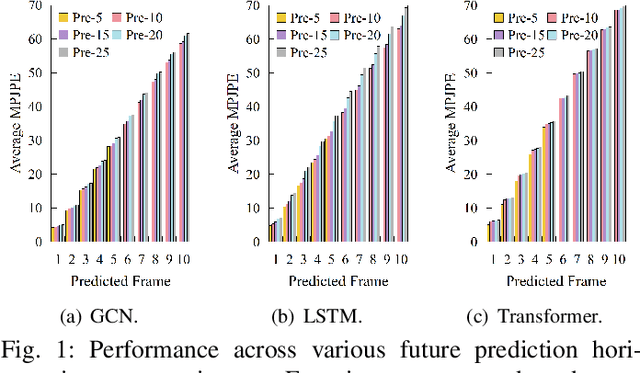
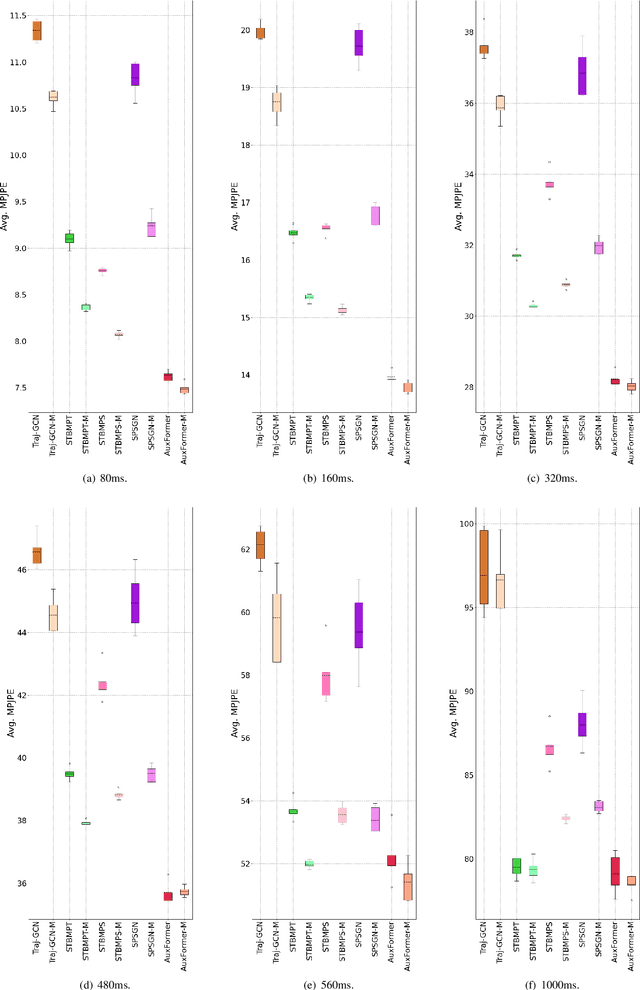
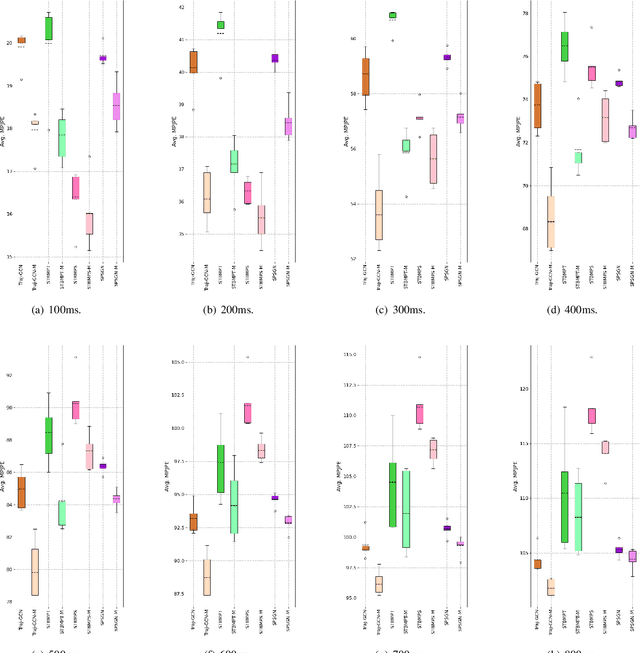
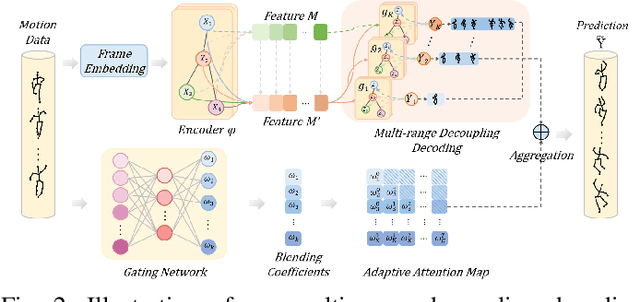
Abstract:Expressive representation of pose sequences is crucial for accurate motion modeling in human motion prediction (HMP). While recent deep learning-based methods have shown promise in learning motion representations, these methods tend to overlook the varying relevance and dependencies between historical information and future moments, with a stronger correlation for short-term predictions and weaker for distant future predictions. This limits the learning of motion representation and then hampers prediction performance. In this paper, we propose a novel approach called multi-range decoupling decoding with gating-adjusting aggregation ($MD2GA$), which leverages the temporal correlations to refine motion representation learning. This approach employs a two-stage strategy for HMP. In the first stage, a multi-range decoupling decoding adeptly adjusts feature learning by decoding the shared features into distinct future lengths, where different decoders offer diverse insights into motion patterns. In the second stage, a gating-adjusting aggregation dynamically combines the diverse insights guided by input motion data. Extensive experiments demonstrate that the proposed method can be easily integrated into other motion prediction methods and enhance their prediction performance.
 Add to Chrome
Add to Chrome Add to Firefox
Add to Firefox Add to Edge
Add to Edge